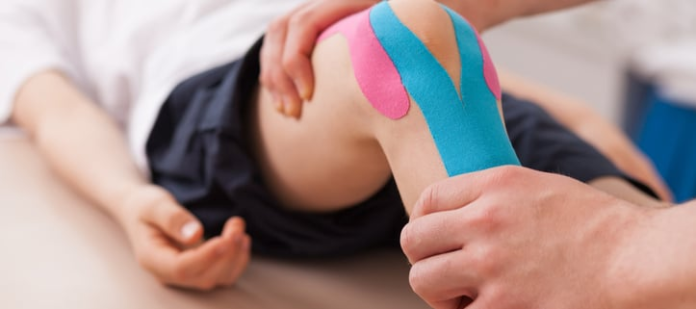If you’re suffering from knee pain, one of the best options to manage it is by using Kinesiology Tape for Knee. It’s a tape often used to treat injuries and reduce muscle fatigue in athletes. It has become popular among people with arthritis, strains, and knee sprains.
Decide where you want to place the tape
When using kinesiology tape, the first step is to decide where you want to place the tape. Generally, you want to apply the tape on the inflamed or painful area. However, you can apply kinesiology tape anywhere to support various muscles in the body. The adherent nature of the tape will allow you to wear it for days without causing irritation or premature peeling.
In this article, we will focus on placing kinesiology tape on the knee. Once you have decided where you want to place the tape, measure the length of tape necessary between those points. Measure from one end of attachment to another point of attachment and add an extra inch or two just in case the tape slightly peels up.
Hampton Adams Kinesiology Tape is one of the top kinesiology tapes designed to help keep your knee stable and strong throughout your workouts and other activities. The tape can be worn for up to seven days. It comes in many colors, such as black, blue, or pink.
Clean your skin thoroughly
Before you apply the tape, clean your skin thoroughly to remove dirt, oil, and any other residue that might interfere with the adhesion of the tape. You can use one of these methods:
- Soap and water
- Rubbing alcohol (isopropyl) or 70% alcohol wipes
- A medical scrub applied with a washcloth and rinsed off after a few minutes
If you have sensitive skin, test an area on your skin before using a new cleaning method.
Cutting the Tape
As discussed earlier, you will need to cut a long strip of kinesiology tape to apply it. The width will vary depending on the surface area you want to cover. For example, if you’re taping only one knee and it’s not swollen or injured, then a 2-inch wide strip is all that you need. However, if your knee is larger or more injured, a 4-inch wide strip may be required to cover all areas that need support during exercise.
Remember that the knee is one of the most important joints in your body and needs to be treated with care. If you have a knee injury, getting the proper support can help you get back on your feet more quickly.
Hampton Adams Kinesiology Tape for your knee is an easy-to-apply, breathable tape. It’s designed to help provide pain relief and support for weak and injured knees. In addition, the tape is comfortable enough to wear for extended periods, so you can use it while you’re at work or playing sports without feeling uncomfortable.
Application of the Tape
When applying Kinesiology tape to your knee cap, ensure you do not put it too low or too high. If you place it too low, it will cover up any pain and discomfort in your patellar tendon; if you put it too high, then you will miss the spot you are aiming to treat! Also, ensure that this layer does not go past where bone meets cartilage (bursa) near the top joint between the femur bone and the tibia bone in your leg. The goal is simply to support muscles around these areas without adding unnecessary bulkiness from having extra adhesive material touching surrounding tissues.
Stretching the Tape
Stretch the middle section of the tape about 75%. The middle section should be stretched when applying kinesiology tape to a joint. This is the most crucial part of the tape application, as it allows maximum stretch and mobility without causing pain or discomfort.
Once you have stretched the middle section of the tape, pull the top part of the tape straight above your knee, leaving a small gap between your skin and the tape. This will allow you to cut easily around your joint line. The gap should be between 1/2 and 1 inch (1-2 cm).
If you have applied kinesiology tape correctly and pulled it tight, there should be no gaps or wrinkles between the tape and your skin. If you see wrinkles or gaps, check that you have stretched out all four corners; this will avoid bubbles under the tape and will allow you the tape to stay sticky for longer.
It’s essential to use a suitable kinesiology tape for your knee. Hampton Adams Kinesiology Tape is designed to relieve pain and swelling in your knees and help increase blood flow and mobility. The tape is made from cotton cloth infused with elastic fibers, making it easy to apply without damaging your skin or causing irritation.
Preserving Stickiness
The final step of applying the tape is to rub-down the ensure length of the tape to remove any air bubbles. The goal of this step is to make sure that the tape stays adhesive for a longer period of time. If you are having trouble with air bubbles, consider using a rolling pin on top of the tape once it’s applied.
Kinesiology Tape has Huge Health Benefits
The most significant benefit of kinesiology tape is decreasing pain and swelling in muscles. Kinesiology Athletic Tape reduces inflammation in the area where the tape has been applied, which can be very helpful for people with chronic injuries or arthritis.
Kinesiology taping also helps improve range of motion by supporting muscles and joints without restricting them. It also helps prevent injury by providing support for muscles and joints during strenuous physical activity.
If you are looking for a way to increase your athletic performance and reduce pain in the knee, Hampton Adams kinesiology tape is a great option. Of course, you must put your tape on correctly to get the most out of it. Follow the tips above to make sure it is properly applied. If you want more information about how to use kinesiology tape or where to find it near you, feel free to contact us at Hampton Adams.































